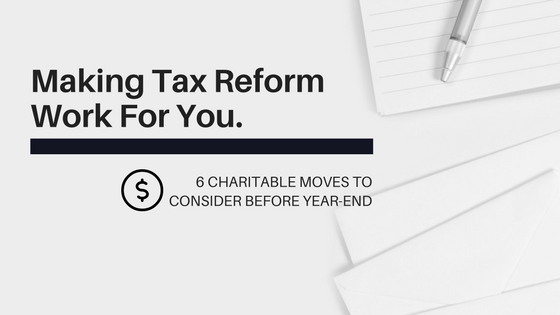Making Tax Reform Work For You: 6 Charitable Moves to Consider Before Year-End
By Stephen Korving, CFP, Co-Founder of Korving & Company, SEVACF Board of Directors
The potential tax changes in the proposed Tax Cuts and Jobs Act (TCJA) are extensive and far-reaching. Given that the House and Senate versions are not identical, there is no way to predict precisely where it will go. However, the proposal does raise the standard deduction, which means that going forward taxpayers will need to provide more itemized deductions in order to receive the tax benefit of excess deductions. You might want to consider these six charitable planning moves before the end of the year given expected changes.
If you itemize your taxes:
-
Donate highly appreciated stocks or mutual funds. The stock market has been on a terrific run, and you may have highly appreciated stocks or mutual funds that you are holding on to because you do not want to pay capital gains taxes. By donating appreciated investments to a qualifying non-profit, including the Southeast Virginia Community Foundation (SEVACF), you avoid paying the capital gains tax and can take a deduction for the fair market value of the investments. If you are considering gifting mutual funds, do so before they declare their year-end dividends and capital gains and you will save on taxes by avoiding that income as well. While your deduction is limited to 50% of your Adjusted Gross Income (AGI), you can carry the unused portion to future tax years.
-
Consider bumping up this year’s contributions: essentially, make contributions that you would have made in 2018 before the end of 2017. The rationale here is that your tax rate is likely to be lower next year than it is this year due to the TCJA, so every additional dollar given this year is deducted against your higher current 2017 rate.
-
If you want to create a legacy or are unsure of where to contribute, use a Community Foundation or Donor Advised Fund (DAF) to max out your contributions. For example, if you give $50,000 to a DAF, you can deduct the entire amount now but designate your gifts and charities over time. You can invest the portion of your DAF that is not immediately donated to a specific charity, creating the potential for even greater giving in the future. You can establish a DAF with SEVACF for as little as $5,000.
-
If you are considering an even larger donation, or are interested in asset-protection, you may want to consider creating either a charitable lead or remainder trust. With a charitable remainder trust, you get a deduction for your gift now; generate an income stream for yourself for a determined period of time; and at the expiration of that term, the remainder of the donated assets is distributed to your favorite charity or charities. A charitable lead trust is essentially the inverse of the remainder trust: you get a deduction for your gift now; generate an income stream for one or more charities of your choice for a determined period of time; and at the expiration of that term, you or your chosen beneficiaries receive the remaining principle. The deduction you receive is based on an interest rate, and the low current rates makes the contribution value high.
-
Donate your extra property, clothes, and household items to charity. Make time to clean out your closets, spare bedroom and garage, and donate those items to one of the many charitable organizations in our area. CHKD, Salvation Army, Purple Heart, ForKids, and Hope House are just a few organizations that will take old clothes, appliances, household items and furniture. Some of them will even come to you to pick up items. Make sure to ask the charity for a receipt and keep a thorough list of what you donated. You can use garage sale or thrift store prices to assign fair market values to the donated items, or you can use online programs (such as itsdeductible.com) to figure out values.
If you are over age 70 ½:
-
Make a Qualified Charitable Distribution (QCD). We discussed this charitable donation method in detail in a column last year, which can be found here: http://bit.ly/2Ak1qAr. Essentially a QCD allows you to donate all or a portion of your IRA Required Minimum Distribution to a qualifying charity. The donated amount is not included in your taxable income and also helps to lower your income for certain “floors” like social security benefit taxation and Medicare Part B and Part D premiums. QCDs are very tax-efficient ways to make charitable donations.




